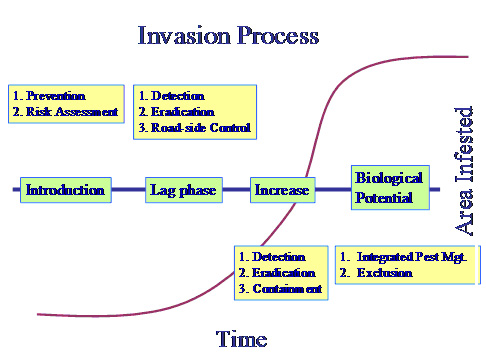Terminology
Native species:
These are general explanations of terms commonly used in the field of invasion biology. For specific Maryland legal definitions,
see Laws.
Control:
Reduce numbers or extent of an invasive species to an acceptably small amount or impact
Eradicate:
Completely eliminate all individuals of a targeted species from an area to which reintroduction will not occur
Established:
Introduced species that are a fixed part of a plant or animal community, reproducing by themselves without support from humans
Exotic species:
Also referred to as: introduced, alien, non-native, non-indigenous. An organism that developed over evolutionary time somewhere other than in a given region. If your given region is Maryland, an exotic species would be one that originated outside Maryland. This term most often refers to species from completely different countries or areas of the world.
An exotic species is not necessarily an invasive species. For example, many of our favorite food crops are exotic. But they are not invasive – they could not exist and spread outside agriculture without the support of humans or affect ecosystem function or biodiversity.
Infestation:
The presence of a given invasive species in a given location. Depending on the scale of the occurrence, an infestation can be a “patch,” acres covered or a population.
Introduced:
Species brought accidentally or on purpose by people to a new location, across a natural geographic boundary, like an ocean or mountain chain that the species would not usually cross naturally.
Invasive species:
The federal definition states that an "invasive species" is defined as a species that is
- non-native (or alien) to the ecosystem under consideration and
- whose introduction causes or is likely to cause economic or environmental harm or harm to human health.
This definition comes from Executive Order 13112, signed by President Clinton in 1999. The Executive Order also established the National Invasive Species Council and directed the drafting of a National Invasive Species Management Plan. (Link to invasivespeciesinfo.gov) In practice, an invasive species is an introduced species that has a negative impact on biological diversity or ecosystem function.
Lag time or lag phase:
The amount of time following a species’ introduction that is required to increase its population to a size that will begin to invade and increase exponentially. Generally, before or during the lag phase is the best time to completely eliminate an invasive species population. After the lag phase, only control is feasible.

Management:
The development and implementation of plans used to control an invasive species.
Native species:
An organism that developed over evolutionary time in a specific region of interest. The “region” is most often defined as a geopolitical area such as a county, state, group of states, such as the Mid-Atlantic, or country. These political boundaries are used largely because regulatory action is taken within political jurisdictions. “Region” can also be defined as an ecosystem or natural boundary, for example, the Chesapeake Bay watershed.
Generally, a species is considered native if it existed in the US before the year 1500.
Naturalized:
Species that have become established in a novel habitat or geographical area to the point where they appear to be native. Plant examples would be Queen Anne’s Lace or Chicory.
Non-native species:
an organism that developed over evolutionary time in a region other than the one in which it is found. See native species.
Noxious weed:
Defined in the federal Plant Protection Act, and regulated by the USDA’s Animal and Plant Health Inspection Service (APHIS) a noxious weed is:
"any plant or plant product that can directly or indirectly injure or cause damage to crops (including nursery stock or plant products), livestock, poultry or other interests of agriculture, irrigation, navigation, the natural resources of the United States, the public health, or the environment." (Plant Protection Act).
Many states have noxious weed laws also. The Maryland noxious weed list consists of six species and the associated species of multiflora rose. These are species regulated by the Maryland Department of Agriculture. See the list and the law on MDA’s website:
https://mda.maryland.gov/plants-pests/Pages/noxious_weeds_in_md.aspx
Population:
a group of individuals of the same species in an area usually specified to make measurements of density or other characteristics (often 1 m2). Often, we will assume that a single patch of a species is a population.
Weed:
Neither a scientific nor a regulatory term, this word is culturally defined and used to refer to “any plant out of place” or “a plant that interferes with management goals” (TNC). But see noxious weed.